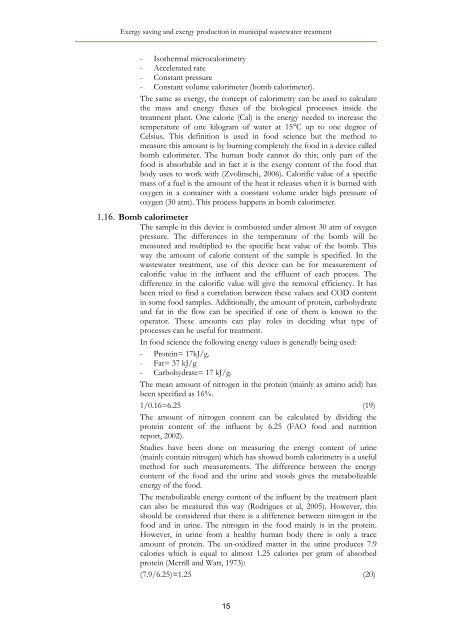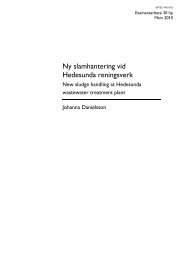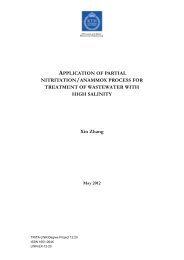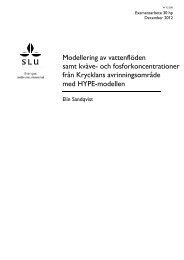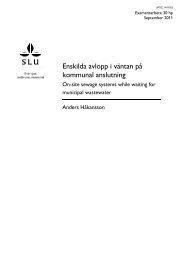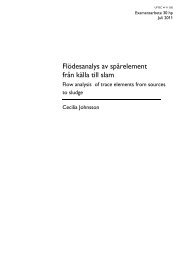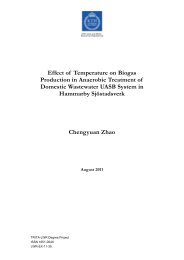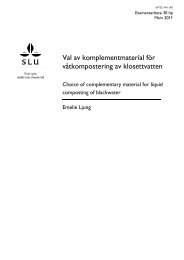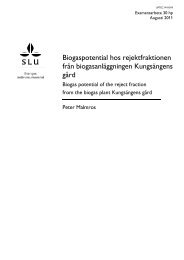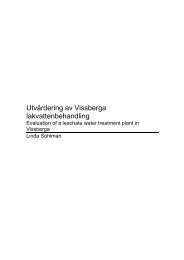Exergy saving and exergy production in municipal wastewater ...
Exergy saving and exergy production in municipal wastewater ...
Exergy saving and exergy production in municipal wastewater ...
Create successful ePaper yourself
Turn your PDF publications into a flip-book with our unique Google optimized e-Paper software.
<strong>Exergy</strong> <strong>sav<strong>in</strong>g</strong> <strong>and</strong> <strong>exergy</strong> <strong>production</strong> <strong>in</strong> <strong>municipal</strong> <strong>wastewater</strong> treatment<br />
- Isothermal microcalorimetry<br />
- Accelerated rate<br />
- Constant pressure<br />
- Constant volume calorimeter (bomb calorimeter).<br />
The same as <strong>exergy</strong>, the concept of calorimetry can be used to calculate<br />
the mass <strong>and</strong> energy fluxes of the biological processes <strong>in</strong>side the<br />
treatment plant. One calorie (Cal) is the energy needed to <strong>in</strong>crease the<br />
temperature of one kilogram of water at 15°C up to one degree of<br />
Celsius. This def<strong>in</strong>ition is used <strong>in</strong> food science but the method to<br />
measure this amount is by burn<strong>in</strong>g completely the food <strong>in</strong> a device called<br />
bomb calorimeter. The human body cannot do this; only part of the<br />
food is absorbable <strong>and</strong> <strong>in</strong> fact it is the <strong>exergy</strong> content of the food that<br />
body uses to work with (Zvol<strong>in</strong>schi, 2006). Calorific value of a specific<br />
mass of a fuel is the amount of the heat it releases when it is burned with<br />
oxygen <strong>in</strong> a conta<strong>in</strong>er with a constant volume under high pressure of<br />
oxygen (30 atm). This process happens <strong>in</strong> bomb calorimeter.<br />
1.16. Bomb calorimeter<br />
The sample <strong>in</strong> this device is combusted under almost 30 atm of oxygen<br />
pressure. The differences <strong>in</strong> the temperature of the bomb will be<br />
measured <strong>and</strong> multiplied to the specific heat value of the bomb. This<br />
way the amount of calorie content of the sample is specified. In the<br />
<strong>wastewater</strong> treatment, use of this device can be for measurement of<br />
calorific value <strong>in</strong> the <strong>in</strong>fluent <strong>and</strong> the effluent of each process. The<br />
difference <strong>in</strong> the calorific value will give the removal efficiency. It has<br />
been tried to f<strong>in</strong>d a correlation between these values <strong>and</strong> COD content<br />
<strong>in</strong> some food samples. Additionally, the amount of prote<strong>in</strong>, carbohydrate<br />
<strong>and</strong> fat <strong>in</strong> the flow can be specified if one of them is known to the<br />
operator. These amounts can play roles <strong>in</strong> decid<strong>in</strong>g what type of<br />
processes can be useful for treatment.<br />
In food science the follow<strong>in</strong>g energy values is generally be<strong>in</strong>g used:<br />
- Prote<strong>in</strong>= 17kJ/g.<br />
- Fat= 37 kJ/g<br />
- Carbohydrate= 17 kJ/g.<br />
The mean amount of nitrogen <strong>in</strong> the prote<strong>in</strong> (ma<strong>in</strong>ly as am<strong>in</strong>o acid) has<br />
been specified as 16%.<br />
1/0.16=6.25 (19)<br />
The amount of nitrogen content can be calculated by divid<strong>in</strong>g the<br />
prote<strong>in</strong> content of the <strong>in</strong>fluent by 6.25 (FAO food <strong>and</strong> nutrition<br />
report, 2002).<br />
Studies have been done on measur<strong>in</strong>g the energy content of ur<strong>in</strong>e<br />
(ma<strong>in</strong>ly conta<strong>in</strong> nitrogen) which has showed bomb calorimetry is a useful<br />
method for such measurements. The difference between the energy<br />
content of the food <strong>and</strong> the ur<strong>in</strong>e <strong>and</strong> stools gives the metabolizable<br />
energy of the food.<br />
The metabolizable energy content of the <strong>in</strong>fluent by the treatment plant<br />
can also be measured this way (Rodrigues et al, 2005). However, this<br />
should be considered that there is a difference between nitrogen <strong>in</strong> the<br />
food <strong>and</strong> <strong>in</strong> ur<strong>in</strong>e. The nitrogen <strong>in</strong> the food ma<strong>in</strong>ly is <strong>in</strong> the prote<strong>in</strong>.<br />
However, <strong>in</strong> ur<strong>in</strong>e from a healthy human body there is only a trace<br />
amount of prote<strong>in</strong>. The un-oxidized matter <strong>in</strong> the ur<strong>in</strong>e produces 7.9<br />
calories which is equal to almost 1.25 calories per gram of absorbed<br />
prote<strong>in</strong> (Merrill <strong>and</strong> Watt, 1973):<br />
(7.9/6.25)≈1.25 (20)<br />
15


